We talked earlier this week about how to attract birds using feeders and water. Since we’re all plant geeks here, I’m dying to share some of my favorite trees for the Pacific Northwest to attract birds.
Do remember that any tree that has fruit or berries is going to be messy, so you should place them within your garden bed so the fruit doesn’t get all over or make your path slippery.
Cornus capitata or Evergreen Dogwood
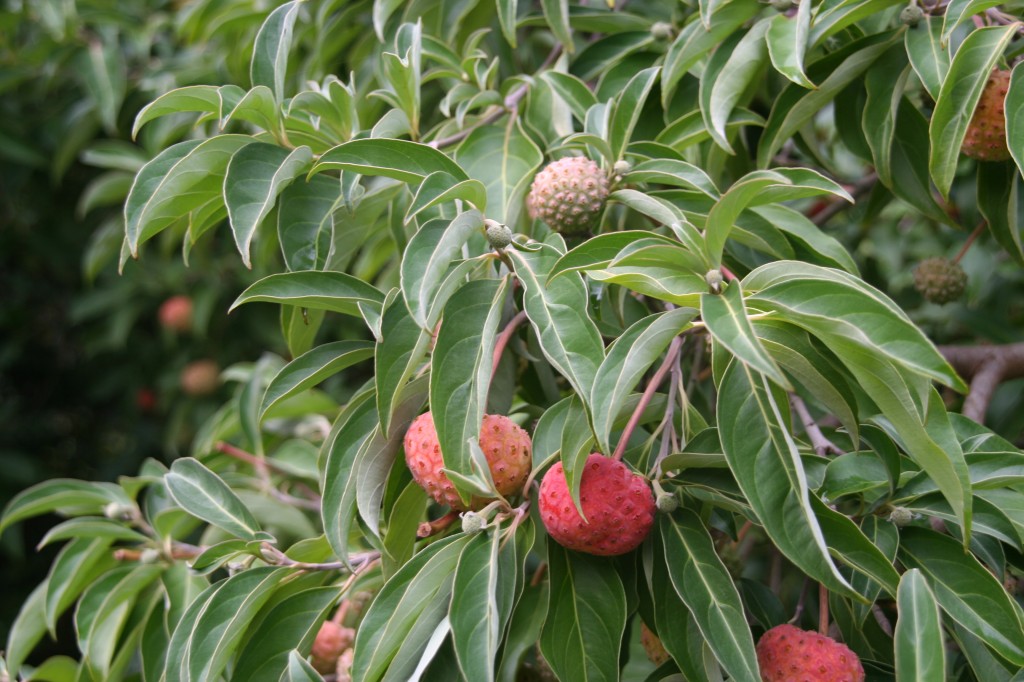
While all the dogwood species offer amazing fruit for birds, usually in late summer to fall, my current plant crush is on the evergreen dogwood, C. capitata.
If you saw it in early summer, covered in creamy-yellow flowers and bracts, you’d think it must be a one-season wonder. “Aha!”, you’d say. “This is why people plant it.”
But I really notice this plant in late fall. When everything else is going dormant, this evergreen beauty is setting vibrant strawberry-like fruits which look gorgeous with all the fall color around. In December, it’s like a Christmas tree – deep green with red decoration.
Then the robins come, clinging onto the branches and tearing into the mealy fruit. What a feast! The berries cling through the winter months, providing food through the hardest parts of the year.
(If possible, get a cutting-grown plant, since they will begin blooming and fruiting for you much sooner than the usual seed-grown ones!)
Liriodendron tulipifera or Tulip Tree
When I was in horticultural school, Liriodendron leaves were the one that gave us all pause. Could it be some strange kind of maple? Some crazy-weird fig?
Turns out it’s a Magnolia relative, which makes perfect sense, since I think of them as the ultimate southern shade tree. They grow fast and big (to 50’+ tall and 30’ wide), and are one of the few trees that doesn’t mind the regular water we often give a lawn.
And if you think the leaves are wild, check out the greeny-orange tulip flowers! Hummingbirds love the nectar provided and will often argue with each other over whose tree it is. Even though it’s deciduous, it makes a great nesting spot and shelter for other birds as well.
There is a splashy gold variegated version called Majestic Beauty or ‘Aureo-marginatum’, and a very slender version called ‘Arnold’ or ‘Fastigiata’ which still gets 50’ tall, but only about 8-15’ wide. ‘Ardis’ is a dwarf to about 15-20’.
Crataegus laevigata or English Hawthorn
Hawthorns are the ultimate bird tree. Robins and others go crazy with joy over all the fruit, and will hang out in your garden poking about for worms and getting plump on berries.
Unfortunately, the most common varieties of English Hawthorn have some issues: ‘Double White’ and ‘Double Pink’ set sparse fruit, not ideal for our bird friends, and ‘Paul’s Scarlet’ is particularly susceptible to a fungal blight which makes it lose its leaves in summer.
The winner for health, looks, and birds? ‘Crimson Cloud’, a gorgeous bright pink bloomer with white centers. It makes loads of bright red fruit in early fall, and it’s resistant to blight, so it will look good for years to come.
A small warning – Hawthorns are, um, thorny, and the scent of their flowers gets mixed reviews, so I usually set them towards the middle or back of a bed, so that they are about 15’ from paths and seating areas.
Acer pennsylvanicum or Snakebark Maple
This is a hard-to-find plant in the Pacific Northwest, but it shouldn’t be! It does beautifully here, and the bark! Oh, the bark. If you think Coral Bark Maples are hot stuff, you have got to see the markings on a Snakebark Maple’s newer branches. Wowee-wow.
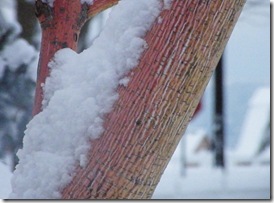 They are slow-growing to 10-20’ and have a lovely form, and a pretty yellow fall color. I think these are going to be the next big craze in maples, as soon as everyone knows about them.
They are slow-growing to 10-20’ and have a lovely form, and a pretty yellow fall color. I think these are going to be the next big craze in maples, as soon as everyone knows about them.
All the other maples are great for birds, too, Japanese Maples included. The little winged seeds are popular with birds, and I often find last season’s nests in them when doing my early-winter pruning. I even see hummingbirds going after the nectar as the new buds break open in spring!
Cone-bearing plants, like Pines, Spruces and Firs
Evergreen conifers provide seeds though some tough times of the year as well. The seeds are inside the cones, and I love to watch the chickadees and sparrows perching on a branch to eat.
All Firs provide food for birds, but the Korean Fir, Abies koreana, is particularly helpful because it bears cones on very young plants. The purple cones are gorgeous in winter, and I try to place Korean Firs near an evergreen plant with purple foliage, like a ‘Plum Passion’ Nandina or a ‘Zhuzhou Fuchsia’ Loropetalum.
The Black Pine, or Pinus thunbergii, is a great garden plant and also bears cones early on. I love ‘Banshoho’, a dwarf variety to about 8’ tall in time, with its glossy green needles and pretty white candles in spring.
Evergreens also provide a wonderful habitat during the winter months, so even plants without seeds or berries can be a real help.
How have you attracted birds to your garden?
Have you tried anything new this year to attract birds into your garden? Let me know in the comments below!
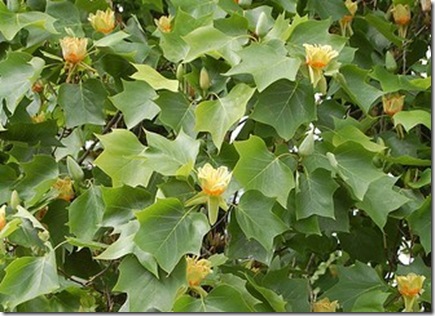
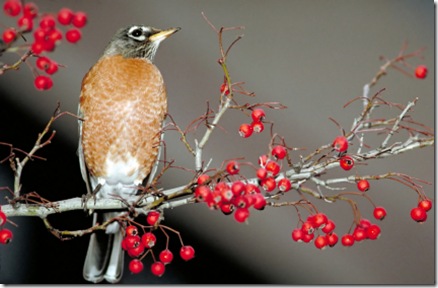
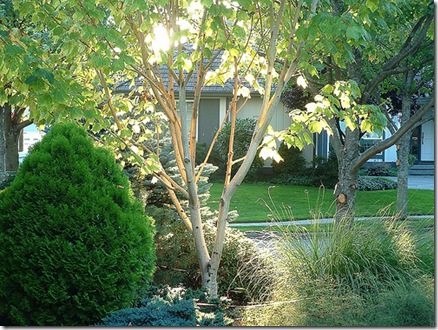
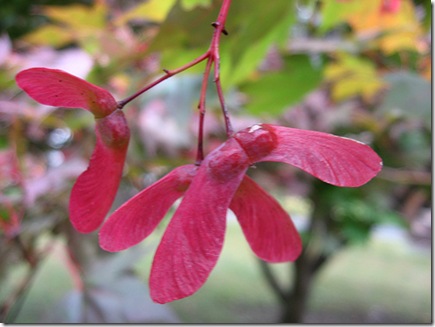
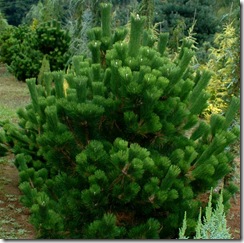
5 responses to “Trees to Attract Birds: New Stars and Old Favorites”
Hi Genevieve, what a great collection of trees. I had never seen the evergreen cornus, although we have many cornus varieties around here. The fruits are fabulous. The older neighborhood we live in is surrounded by American hollies, mature and tall and loaded with berries. I believe it accounts for our cardinals, they love those holly berries. I have been working to plant shrubs with berries too, concentrating on the viburnums. They are too small yet for blooming, but one of these days the birds are going to say *thanks!* 🙂
Frances
Frances’s last blog post..Greenhouse/Sunroom Of Plenty
Oh, Frances, you are so right – they are going to love the viburnums! How neat that you have so many American Hollies about – they are so stately. I can just imagine the cardinals on them – red on red.
Hi Gen
The Evergreen Dogwood is now on my wish list for this spring. I will definitely get one from a cutting if I can. I am not waiting 8-10 years for it to bloom. This is so exciting!! Buying plants to help my beautiful Jays. If I keep it as a shrub will the deer be a problem? We’re getting close to putting up a fence and a gate to keep out those varmits.
Aha! You’ve helped me identify cornus capitata – thank you! As a visitor to Seattle from the UK, I was curious about these lovely red fruits – the landscapers have placed them all around the business areas here.
Your pic of a robin reminded me of one of those US-UK language differences. The American robin is a type of thrush; what we call robin in the UK is a much smaller bird, which comes up close whenever you are turning over earth in the garden, and eats the arthropods you’ve exposed. I’ve read that although it has no close relatives in Europe, it is related to the small birds that stand on the backs of hippopotami in Africa. http://www.ephotozine.com/photo/1437240/large
[…] Bird-Attracting Trees […]